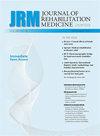Community integration and its predictors in people with stroke: a multicenter longitudinal study.
IF 2.5
4区 医学
Q1 REHABILITATION
引用次数: 0
Abstract
OBJECTIVE To investigate the community integration of patients following stroke and determine the predictors of their level of community integration at 1-year follow-up. DESIGN A multicenter, longitudinal, and observational study. SUBJECTS Sixty-five inpatients (41 men) with a mean age of 56.9 (standard deviation = 17.0) years, who had their first stroke at least 1 month prior to this study were recruited from 4 rehabilitation inpatient wards in China. METHODS In the initial assessment, the participants were evaluated using the Community Integration Questionnaire, the Fugl-Meyer Assessment, the Berg Balance Scale, the Modified Barthel Index, the Mini Mental State Examination, and the Modified Ashworth Scale. In the follow-up assessments, which were conducted via telephone no less than 1 year after discharge, the participants were evaluated using the Community Integration Questionnaire and also assessed for other disease-related conditions. RESULTS The participants' scores on the Community Integration Questionnaire in the follow-up assessment were significantly greater than those at the initial assessment (p < 0.05). In addition, the participants' Community Integration Questionnaire scores in the follow-up assessment were significantly correlated with their ages, numbers of years of education, and Modified Barthel Index, Berg Balance Scale, Mini Mental State Examination scores in the initial assessment (p < 0.05), and marginally significantly correlated with their scores on Fugl-Meyer Assessment in the initial assessment (p = 0.058). The participants' ages, numbers of years of education, and Modified Barthel Index, Berg Balance Scale, Mini Mental State Examination, Fugl-Meyer Assessment of the lower extremity, and Fugl-Meyer Assessment scores in the initial assessment were predictive of their Community Integration Questionnaire scores at follow-up, with coefficients of determination ranging from 0.254 to 0.056 (p < 0.05). CONCLUSIONS The level of community integration of the participants was generally low, but it was greater at 1-year follow-up than it was initially. Balance function and daily living ability may be key predictors of community integration of patients following stroke.中风患者的社区融合及其预测因素:一项多中心纵向研究。
目的调查脑卒中患者的社区融合情况,并确定随访 1 年时其社区融合水平的预测因素。方法在初始评估中,使用社区融合问卷、Fugl-Meyer 评估、Berg 平衡量表、改良 Barthel 指数、迷你精神状态检查和改良 Ashworth 量表对参与者进行评估。在出院后不少于 1 年通过电话进行的随访评估中,参与者使用社区融合问卷进行评估,并对其他与疾病相关的情况进行评估。此外,参与者的社区融合问卷随访得分与他们的年龄、受教育年限、改良巴特尔指数、伯格平衡量表和迷你精神状态检查的初次评估得分有显著相关性(p < 0.05),与他们的福格-迈耶评估的初次评估得分有微弱相关性(p = 0.058)。参与者的年龄、受教育年限、改良巴特尔指数、Berg 平衡量表、迷你精神状态检查、下肢 Fugl-Meyer 评估和 Fugl-Meyer 评估在初次评估中的得分可预测其在随访时的社区融合问卷得分,决定系数在 0.254 至 0.056 之间(p < 0.05)。平衡功能和日常生活能力可能是预测脑卒中患者融入社区的关键因素。
本文章由计算机程序翻译,如有差异,请以英文原文为准。
求助全文
约1分钟内获得全文
求助全文
来源期刊
CiteScore
5.60
自引率
5.70%
发文量
102
审稿时长
4-8 weeks
期刊介绍:
Journal of Rehabilitation Medicine is an international peer-review journal published in English, with at least 10 issues published per year.
Original articles, reviews, case reports, short communications, special reports and letters to the editor are published, as also are editorials and book reviews. The journal strives to provide its readers with a variety of topics, including: functional assessment and intervention studies, clinical studies in various patient groups, methodology in physical and rehabilitation medicine, epidemiological studies on disabling conditions and reports on vocational and sociomedical aspects of rehabilitation.

 求助内容:
求助内容: 应助结果提醒方式:
应助结果提醒方式:


